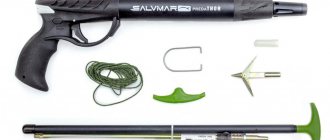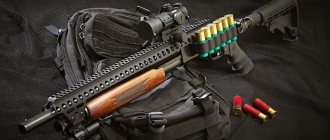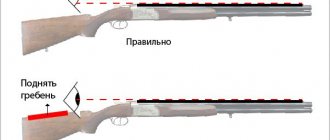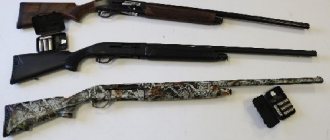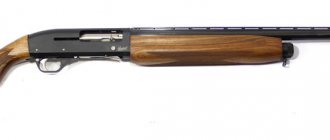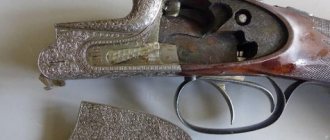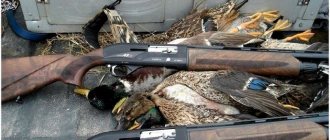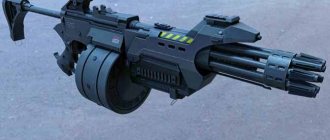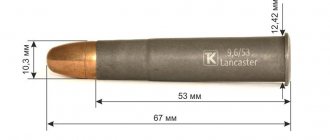This original speargun design is easy to manufacture and has quite powerful destructive power. With such a gun you can successfully catch quite large fish in various bodies of water. Next, we will briefly look at the structure of a spring underwater gun, as well as what materials its parts can be made from. The figure below shows a longitudinal section of a spring speargun.
Options for attaching a harpoon to a gun
Three methods of attaching a harpoon to a gun are most in demand among underwater hunters:
- front;
- front with sliding bushing;
- rear
As you understand, each type has certain characteristics, but there are also some disadvantages. It is believed that the rear clutch is characterized by the greatest reliability and efficiency. But is this really so? To understand the mechanism of such a system, you need to consider in detail the principle of its operation.
Rating of underwater guns
Based on their design features, there are 4 types of devices: spring, pneumatic, crossbow and hydropneumatic. The first ones are considered the simplest and are used when catching large fish that are able to resist after being shot. Crossbows are very popular among beginners because they have no recoil and are characterized by low noise. Pneumatics show the best efficiency, but operating such devices requires a lot of experience. The last option is considered the most expensive due to the possibility of underwater hunting under any conditions, even in reservoirs with dense vegetation. When testing the nominees, specialists from the website Vyborexperta.ru conducted a comparative analysis of the following characteristics:
- Length of gun, recommended harpoon;
- Material of the barrel, handle;
- Weight;
- Diameter of the piston, throwing gun;
- Range of target destruction, harpoon flight;
- Types of elements included;
- Sight accuracy;
- Additional functions;
- Noise level;
- Reliability;
- Ease of use;
- Price.
The review contains the best underwater guns of the pneumatic and crossbow type. When choosing the latter, the features of the rods were taken into account, which affect the power and accuracy of the model. Each section provides a description, pros and cons of operating the devices.
The best camera traps for hunting
The moment of the shot
When we are dealing with a front mount and a mount with a sliding sleeve, then the line is released and it begins to gain speed even when the piston presses on the harpoon. The firing principle of a rear-mounted harpoon is different: it begins to gain speed under the influence of its own force, and accordingly, a large amount of accumulated energy is lost during the shot itself.
The situation is no better with the level of noise emitted. For a front-mounted harpoon with a sliding sleeve, the line partially absorbs the impact, so sound vibrations are damped. The rear mount does not have this advantage, since the shank hits the bushing with loud noise.
How to properly charge a pneumatic gun
When the gun is inflated with compressed air, the piston pushes against the muzzle shock absorber. We insert the harpoon and move it into the barrel - it should catch on the sear. Now we put the trigger on the safety and remove the charging handle, doing this as quickly as possible.
With pneumatic guns, it is very important that the harpoon goes straight into the barrel, without distortion. To do this, hold on to the receiver with one hand, closer to the barrel. And one more thing: both ends of the weapon must be directed away from you. And from other people too, naturally.
Hitting the target
In this parameter, the rear mount also loses, since the reliability of hitting a target right through with a harpoon with a front hitch is higher. This is ensured by subsequent pulling of the line, due to which the harpoon stands across. In addition, the likelihood that a rear-mounted harpoon will penetrate the target is very small, since the cross-sectional area increases.
Even if we consider hitting the target right through, the rear mount, similar to the previous point, turns out to be less reliable.
What does it consist of?
The design of this weapon is designed in such a way that the harpoon is pushed by returning rubber rods to their place. The components of the device are a barrel with a handle, rubber rods, a head, a hook, a trigger (trigger mechanism) and a harpoon. By putting all the components together, you can get a fairly devastating weapon for underwater fishing.
According to the shape of their manufacture, the trunks can be smooth, cylindrical, or uneven, with bends. The purpose of the barrel is to hold the harpoon and withstand the loads from the tension of the rubber rods. Factory gun barrels are made from durable aluminum, wood, or fiberglass. A homemade crossbow for underwater hunting can be made from wood, preferably durable types of trees, or from an aluminum pipe. Wooden crossbows are lightweight underwater, but less mobile than aluminum ones.
Pulling out the harpoon
Often, tricksters have to hunt in bodies of water overgrown with seaweed, littered with fallen branches and tree trunks. All this creates serious obstacles not only to movement, but also leads to the loss of the harpoon. If it is attached to the gun at the front, then the probability of the line breaking is higher, since the harpoon will become across when dragged. Even if you take it out, it will bring with it a lot of unnecessary junk.
With the rear fastening of the harpoon, the situation is radically different - it is pulled out in reverse, so the likelihood of damaging the line or catching foreign parts is minimal. A front mount with a sliding sleeve can work 50/50, it all depends on the tactics of pulling the harpoon.
Manufacturing process
To make a weapon with your own hands, you need to find a wooden board approximately 6–8 cm thick, on which we draw a drawing of the future weapon. The drawing can be taken from the drawings, or you can choose the appearance of the crossbow to suit yourself. The trunk length should not exceed 76 cm for the first time. You should also draw a handle. After this, we cut out the crossbow using a saw or grinder with a special wood cutting wheel.
After you have cut out the gun blank, you need to clean up the sharp edges using an angle grinder with an emery wheel or file and sandpaper. On top of the gun along the barrel we make a recess for the arrow. We use a grinder or jigsaw.
The next task is to make holes for the rubber rods and the trigger mechanism.
Materials needed to make a trigger: a metal plate 10x15 cm and about 3 mm thick, three bolts and six M12 nuts, two bolts and two M10 nuts, two small springs or a rubber stretch ring. A door lock may be suitable as a plate. It is necessary to draw two figures on squared paper so that the squares show what size is needed. We transfer the image to the plates and cut out these shapes. Be sure to clean the manufactured parts, they will be the trigger. Next you need to cut out the side parts of the trigger. We make holes in the metal, attach springs or rubber and fasten the side parts.
The holes for the trigger mechanism are made using a drill or jigsaw and must match the dimensions of the previously made trigger. The hole for the rods is made in the front and side of the barrel. The diameter should also match the diameter of the rubber bands. At the bottom end of the gun, small cuts should be made with a hacksaw in order to thread a line through them.
Design Features
According to this parameter, the front mount is more reliable, since the piston is less damaged. And it’s much easier to do, since you don’t need to think about fixing the sliding sleeve. In the case of a rear mount, this cannot be avoided, otherwise the accuracy of the hit will decrease.
Hitting the target is most likely with a front mount. Here, the harpoon is fixed at two points, so as it moves, it clearly remains within the boundaries of the original trajectory and does not shift along the axis. At the rear mount, if you do not think through the bushing fixation system, a serious shift of mass occurs forward. This should be taken into account when calculating the shot trajectory.
Another important factor is that the front-mounted system is better sealed. This is explained by the fact that there is no need to pass the thickened shank through the cuff.
Best crossbow
Ideal options for beginners
are Seac sub sting and Omer Cayman. Among the advantages are the low price and active line discharges (the second one has a side one).
The second crossbow can be chosen in a higher price range: Demka Ami 2, Salvimar Voodoo, Cressi sub Comanche. Line drops and harpoons are stainless metal. The only disadvantage of Demka Ami 2 is the inability to use harpoons from other companies.
True spearfishing fans will love the Salvimar Voodoo rail, Omer Cayman GI and Seac sub Twin Thunder. All have a guide (the first one has rollers), so the accuracy is much greater.
Among the professional crossbows: Demka ALC with two rods, Seac sub X-fire with a ring and OmerHFCamo 3D. All are distinguished by their high combat power, and the last one has a hydroformed barrel.
The Omer Cayman ET with a non-standard hydroformed barrel was recognized as the best crossbow. The model is the most accurate yet, using a shark fin grip, an all-metal hammer and trigger, and elastic cords. This is a top class crossbow.
How to smooth out the shortcomings of the front mount
The only drawback revealed during our comparison is the presence of a loop that forms when the gun is loaded. Indeed, it is not particularly comfortable, especially when you are wearing thick gloves. But this drawback can be smoothed out by doing the following:
- disconnect the line that is attached to the sliding sleeve;
- put the ring on the part of the line that connects the harpoon to the sleeve;
- tie the main line to the ring.
Having performed these simple manipulations, we get the following: the loop will still be needed, however, when the time comes to lay the line, it will tighten by pulling the main line. When the shot comes, the harpoon will move forward and pull the line behind it, and it will move along the ring. Here it will play the role of a guide. As soon as the ring rests against the sliding sleeve, it will remain under the line, this will lead to the main line being pulled out.
Typically, spearfishers use smooth metal rings. They damage the structure of the line less, are quite light and durable, which is also important. If a suitable ring is not found, you can go the other way and exclude not only its design, but also the bushing. This can be done by replacing them with loops made of tench. There may be several options here, but the main point of all manipulations is to make sure that the main line moves along the guide.
The sliding sleeve can be left, but it will need to be modified to reduce hydraulic resistance. This can be done by reducing the size of the sleeve and fastening.
The fastening itself can be made from ordinary tench, or you can spend a little more money and buy a dyneema cord, which is stronger and more reliable. With the main line, everything is as usual - you can use any type, including cheap ones.
DIY spearfishing gun
Spearfishing has recently become a very popular activity. This sport attracts more and more people who are ready to test themselves in an unusual environment.
But desire alone is not enough; to hunt underwater you will need special equipment, many different accessories and, of course, weapons.
All this costs a lot of money, and if at first you can do without a wetsuit, trying your hand at shallow water, then you definitely won’t be able to catch a large fish with your bare hands. In general, hunting without a gun is like playing football without a ball.
Today, specialized stores offer hunters four types of underwater weapons. These are crossbows, pneumatic guns, hydropneumatic guns, as well as spring-type guns.
The price of finished products is quite high; not everyone can afford such a “toy”.
But don’t give up because of this the dream of catching carp or catfish by meeting the enemy, what is called face to face. In no case!
If you can’t raise money, then the only way out of the situation is to make an underwater gun yourself.
You will have to work hard: carefully study the drawings, choose the best option, find or buy all the necessary materials, and perhaps even remember labor lessons from school. But it's worth it.
The result of your efforts will be an excellent homemade gun, with characteristics almost equal to the factory one.
How to achieve big catches?
Over many years of practice in catching various types of fish, the most effective methods have been found:
Parts and materials for their manufacture
It must be said right away that air guns have an overly complex design, so it’s better to stick with spring guns. This is the simplest and most affordable option for self-assembly. To assemble it, you will need the following elements:
Source: https://AktSport.ru/dayving/kak-sdelat-arbalet-dlya-podvodnoy-ohotyi.html
